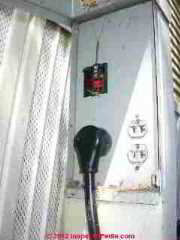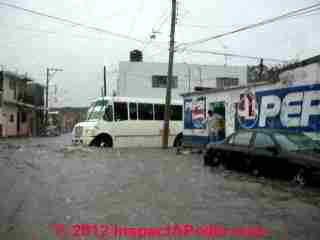 How to Turn OFF Electricity at a Wet or Flooded Building
How to Turn OFF Electricity at a Wet or Flooded Building
Procedural Details from Flood Damage Repair Guide FEMA/ARC expanded Step 2
- POST a QUESTION or COMMENT about how to how to turn OFF electricity at a wet or flooded building
Flood damage to buildings, Step 2: How to Turn OFF Electricity at a Wet or Flooded Building.
Here we provide a safety checklist to follow before even attempting to turn off the electricity. Once safe to do so, we discuss where and how to turn off the power to the building.
If your building has been flooded, this article series gives an easy to understand guide for flood damage assessment, setting priorities of action, protecting the building from further damage, and then cleaning up a wet or flooded basement or building and restoring its electricity, heat, plumbing to working condition, then restoring and rebuilding the damaged building areas and flood proofing it against a future problem.
We describe disaster repair safety, and we provide special information about avoiding or minimizing mold damage. Adapted and expanded from Repairing your Flooded Home, American Red Cross & FEMA & from additional expert sources. [1] NOTICE: neither the ARC nor FEMA have yet approved the additions & expansions we have made to the original document.
InspectAPedia tolerates no conflicts of interest. We have no relationship with advertisers, products, or services discussed at this website.
- Daniel Friedman, Publisher/Editor/Author - See WHO ARE WE?
How to Turn Off Electrical Power at a Building that has been Wet or Flooded
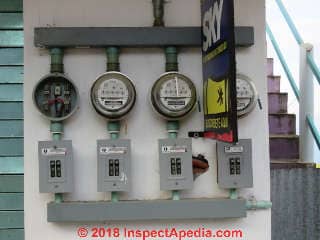 The presence of electricity at a wet or flooded building creates a high risk of death by fatal electric shock. In order to reduce that risk and stay safe, there are a number of necessary steps to follow in the proper order to turn the electricity off.
The presence of electricity at a wet or flooded building creates a high risk of death by fatal electric shock. In order to reduce that risk and stay safe, there are a number of necessary steps to follow in the proper order to turn the electricity off.
Photo: a bank of electric meters, one meter (at left) removed, and below each meter, a main electrical switch panel at a building in Oaxaca, Mexico.
Before even attempting to turn off electrical power, review this
Safety Checklist after Flooding
- Wait for the water to go down
before attempting to inspect or enter a building - Report downed power lines and stay away
from them as well as from any buildings, trees, vehicles, etc. that such line may be touching - Report gas leaks and do not enter
and stay well away from any building where there is odor or other evidence of a gas leak - Check for evidence of structural damage
such as collapsing roofs, walls, ceilings, foundations - Turn off electricity
to the building - details below in this article
Do not touch electrical equipment if it is wet or if you are standing in water. If it is safe to do so, turn off electricity at the main breaker or fuse box to prevent electric shock. - Turn off gas or fuel supply
to the building - details below in this article
Should I turn off Electricity or Gas first?
Normally you can turn off either gas or electric first - whichever is more accessible. For example: there may be an outdoor gas shutoff and you might have to go indoors to get to the main electrical switch in an indoor panel - in that case, turn off the gas first.
But
Watch out: if you smell gas or for any other reason you think there has been a gas leak, do not turn ANY electrical devices or switches on or off. A spark from a switch could cause an explosion.
If you can safely turn off the gas supply do that immediately, then when the building has had time to be ventilated so that there is no accumulated gas, it should be safe to turn off electricity.
If not, go to a safe, distant location (some cellphones might also create an igniting spark), and call for emergency services to turn off the utilities.
Watch out: if you are on wet ground or have to go through water, if your home is flooded, or if any electrical component is wet, do not touch any electrical switches or panels. If you do, you risk death by fatal electric shock. Call an electrician.
When it is Safe to Do So, Turn Off Gas or Fuel Supply
There is a valve next to the gas meter. If the valve handle is parallel to the pipe, the gas is on. You may need a pair of pliers or a wrench to turn the valve. Turn it 90 degrees (a quarter turn) so the handle is perpendicular to the pipe to shut the gas off.
Turn off the fuel valve at the tank and be sure to follow the instructions in Step 5: Restore Utilities After Flooding (cited below in this article) before you turn the fuel back on.
See more specifics for turning off the fuel supply at
TURN OFF ELECTRICAL POWER & FUEL FOR OIL OR GAS HEATING EQUIPMENT
When it is Safe to Do So, Turn Off Electrical Power
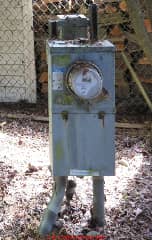 Above: an outdoor electric meter and (behind the hinged cover) main electrical switch at a building in Port Angeles, Washington.
Above: an outdoor electric meter and (behind the hinged cover) main electrical switch at a building in Port Angeles, Washington.
Turn off the electricity supply to the wet or flooded building.
The electricity supply to the building must be turned off at the building's main breaker box or fuse box.
Watch out: Electricity and water don’t mix, so turn the power off at your home! Touching any live electrical component, wire, switch, receptacle, or plugged-in electrical device in a wet or flooded building risks death by fatal electric shock.
If you can get to your electric box without going through or standing in water, you can turn off the power yourself.
Watch out: If you would have to step in water to get to your electric box, call an electrician, don't enter the wet area before you are certain that electrical power is completely OFF at the building.
If your main electrical power switch is outside the building
Turn off the main electrical switch, or if there are multiple switches labeled MAIN, turn ALL of them OFF.
Watch out: a few problem-brand electrical panel circuit breakers including FPE / Federal Pacific / Federal Pioneer / Federal Electric, and Bulldog Pushmatic brands may remain "ON" internally, electrically, even when the switch is in the "OFF" position.
If your electrical panel is one of those brands, you need help from an electrician who knows how to use simple test equipment like a neon tester or volt meter to confirm that electrical power is really "OFF".
If your main electrical power switch is inside the building
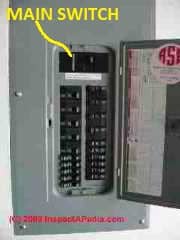 Remember that if the electrical or gas controls are inside the home, do not turn them off until you can safely enter your home.
Remember that if the electrical or gas controls are inside the home, do not turn them off until you can safely enter your home.
That means that you don't walk in water or on a wet floor to reach and turn off the main switch in an electrical panel.
Our photo shows the main switch at an indoor electrical panel.
See examples of main electrical switches
You must Turn the Main Switches OFF - Don't Just Rely on the Power Company who may have turned power off to your neighborhood
Even if the power company has turned off electricity to the area, you must still make certain your home’s power supply is disconnected.
You don’t want the power company to turn it on without warning while you’re working on it.
If the Electric Meter Has Been Removed
Your utility company may have removed your electric meter. Usually, but not always, this should turn off the power.
We say "usually" because depending on what electrical wire connections, including "temporary" connections, that someone may have made in the electric meter box, simply removing the electric meter does not always turn off the power.
Turning Off Electricity at Fuse Boxes
- Stand on a dry spot.
- If your box has a handle on the side, use a dry wooden stick or pole to pull the handle to OFF.
- Use the stick to open the door.
- Carefully pull out the main fuses. Use a dry wooden stick.
- Unscrew and remove each circuit fuse main breaker.
- See ELECTRICAL SAFETY for FLOOD DAMAGE INSPECTORS
Turning Off Electricity at Circuit Breaker Boxes
Photo above: the electrical supply and main switch at an outdoor standard used to provide electricity to a mobile home, doublewide, or trailer home.
- Stand on a dry spot.
- Use a dry wooden stick or pole to open the door.
- Use the stick to push the main breaker switch to OFF.
- Use the stick to turn each circuit breaker to OFF STEP
- See ELECTRICAL SAFETY for FLOOD DAMAGE INSPECTORS
See also
See also
ELECTRICAL SAFETY for FLOOD DAMAGE INSPECTORS
Watch out: Later when flood waters have subsided and the building is being cleaned, there will still be electrical safety concerns:
Protection from electrical shock: Because of the danger of shocks and fire, electrical receptacles that were flooded should not be used to operate cleaning or drying equipment. An electrician should evaluate the condition of flooded components prior to use.
As a rule, all flooded receptacles should be removed and replaced after the appropriate circuit breakers or fuses are deactivated and the interruption of power to the receptacle confirmed. - Source: CLEANING FLOODED BUILDINGS Hurricane Sandy Recovery Fact Sheet No. 1 [PDF] FEMA
When Can You Turn Electrical Power Back On after a Building Has Been Flooded?
Keep power off until an electrician has inspected your system for safety.
When an electrician confirms that it is safe to do so, and it's time to turn power back on,
see Step 5. RESTORE UTILITIES AFTER FLOODING
Post Flood / Disaster Electrical System Safety
- FLOOD | SYSTEMS INSPECTIONS (ELECTRICAL EQUIPMENT) [PDF] FEMA,
Watch out: Do not touch electrical equipment if it is wet or if you are standing in water
Footnotes to references cited in the document above:
[1] United States, Department of Health and Human Services, Centers for Disease Control, National Institute for Occupational Safety and Health, “Electrical Safety: Safety and Health for Electrical Trades, Student Manual,” 2009, 31-32.
[2] Sebastian Jonkman and Ilan Kelman, “An Analysis of the Causes and Circumstances of Flood Disaster Deaths,” Disasters 29, no. 1 (2005), 85.
[3] Ilan Kelman and Robin Spence, “An Overview of Flood Actions on Buildings,” Engineering Geology 73 (2004), 304. - PROTECTING BUILDING UTILITIES FROM FLOOD DAMAGE [PDF] (2017) FEMA P-348, Edition 2 / February 2017, retrieved 2023/07/30, original source: fema.gov/sites/default/files/2020-07/fema_p-348_protecting_building_utility_systems_from_flood_damage_2017.pdf
- SAFE CLEANUP AFTER THE FLOOD [PDF] (2017) FEMA, retrieved 2023/07/30, original source: fema.gov/press-release/20230425/safe-cleanup-after-flood
Excerpt:
Protective Actions
Do not touch electrical equipment if it is wet or if you are standing in water. If it is safe to do so, turn off electricity at the main breaker or fuse box to prevent electric shock.
If the area around the service equipment is wet or the service equipment itself is wet, have a qualified professional address the situation.
Turn off electricity if you smell hot insulation or see damaged wires.
If you are unfamiliar with your home’s electrical systems, contact the local power company or a qualified electrician for assistance.
...
Continue reading at Step 3. GET ORGANIZED for assessing and repairing flood damage, or select a topic from the closely-related articles below, or see the complete ARTICLE INDEX.
Or see these
Recommended Articles
- BUILDING ENTRY for FLOOD DAMAGE ASSESSMENT for an explanation of how to enter a building safely in order to inspect its condition or begin dryout and repairs
- FLOOD REPAIR PRIORITY STEPS
- FLOOD RESPONSE CHECKLIST - list of items to address in priority order .
- SAFETY ADVICE ABOUT USING PORTABLE GENERATORS
- MAKE SURE IT IS SAFE TO GO BACK INSIDE
- SUPPLIES, TOOLS & EQUIPMENT YOU WILL NEED WHEN IT IS SAFE TO RETURN HOME
- HOW TO TURN OFF ELECTRICITY in a WET or FLOODED BUILDING
- HOW TO TURN ON ELECTRICITY - RESTORE UTILITIES AFTER FLOODING - How to Turn Electricity Back ON
- BUILDING ENTRY PROCEDURES AFTER DISASTER OR FLOODING: Enter Carefully
- RESCUE THE MOST VALUABLE ITEMS in the Building after a Flood
- DOCUMENT BUILDING DAMAGE & EXPENSES
- PROTECT YOUR HOME FROM FURTHER DAMAGE after Flooding or Disaster
- HOW TO DRAIN A FLOODED BASEMENT OR CRAWL SPACE
- 8 STEPS TO CLEAN OUT THE BASEMENT AFTER A FLOOD
- FLOOD & DISASTER BUILDING DAMAGE REPAIR PROCEDURES - home
- HURRICANE DAMAGED BUILDINGS
- HURRICANE, WIND, & STORM-RESISTANT WINDOWS
- WIND DAMAGED BUILDINGS
Suggested citation for this web page
HOW TO TURN OFF ELECTRICITY in a WET or FLOODED BUILDING at InspectApedia.com - online encyclopedia of building & environmental inspection, testing, diagnosis, repair, & problem prevention advice.
Or see this
INDEX to RELATED ARTICLES: ARTICLE INDEX to ELECTRICAL INSPECTION & TESTING
Or use the SEARCH BOX found below to Ask a Question or Search InspectApedia
Or see this
INDEX to RELATED ARTICLES: ARTICLE INDEX to BUILDING DAMAGE, DISASTER, REPAIRS
Or use the SEARCH BOX found below to Ask a Question or Search InspectApedia
Ask a Question or Search InspectApedia
Try the search box just below, or if you prefer, post a question or comment in the Comments box below and we will respond promptly.
Search the InspectApedia website
Note: appearance of your Comment below may be delayed: if your comment contains an image, photograph, web link, or text that looks to the software as if it might be a web link, your posting will appear after it has been approved by a moderator. Apologies for the delay.
Only one image can be added per comment but you can post as many comments, and therefore images, as you like.
You will not receive a notification when a response to your question has been posted.
Please bookmark this page to make it easy for you to check back for our response.
IF above you see "Comment Form is loading comments..." then COMMENT BOX - countable.ca / bawkbox.com IS NOT WORKING.
In any case you are welcome to send an email directly to us at InspectApedia.com at editor@inspectApedia.com
We'll reply to you directly. Please help us help you by noting, in your email, the URL of the InspectApedia page where you wanted to comment.
Citations & References
In addition to any citations in the article above, a full list is available on request.
- [1] REPAIRING YOUR FLOODED HOME [PDF], American Red Cross & FEMA: Federal Emergency Management Agency, FEMA PO Box 2012, Jessup MD 20794-2012. Printed copies of this book are available from the American Red Cross, from your local Red Cross chapter, or by writing to the address above. Web search 10/4/2010, original source: http://www.redcross.org/www-files/Documents
/pdf/Preparedness/file_cont333_lang0_150.pdf - [2] The following are available free from:
Federal Emergency Management Agency Attn: Publications P. O. Box 2012 Jessup, MD 20794-2012- Design Manual for Retrofitting Flood-prone Residential Structures, FEMA-114. This detailed manual explains all the floodproofing options in language a homeowner can understand.
- Elevated Residential Structures, FEMA-54.
- Floodproofing Non-residential Structures, FEMA-102.
- Coastal Construction Manual, FEMA-55.
- Manufactured Home Installation in Flood Hazard Areas, FEMA 85.
- [3] The following are available for free from:U.S. Army Corps of Engineers Attn: CECW-PF 20 Massachusetts Avenue, NW Washington, D.C. 20314
- Introduction to Flood Proofing, John R. Sheaffer, 1967
- Flood-Proofing Regulations, U.S. Army Corps of Engineers, Pittsburgh District, 1990, 80 pages (Corps publication EP 1165 3 314).
- Flood Proofing Systems & Techniques, L.N. Flanagan, editor, 1984
- Flood Proofing Tests, Tests of Materials and Systems for Flood Proofing Structures, Corps of Engineers, National Flood Proofing Committee, August, 1988.
- Raising and Moving the Slab-On-Grade House, Corps of Engineers National Flood Proofing Committee, 1990.
- [4] The following publications are available from the American Red Cross. Contact your Red Cross chapter for more information:
- Your Family Disaster Plan (ARC 4466)
- Su plan para el hogar en caso de desastres (ARC 4466S)
- Your Family Disaster Supplies Kit (ARC 4463)
- Su Equipo de suministros para la familia en caso de desastres (ARC 4463S)
- Safe Living in Your Manufactured Home (ARC 4465)
- Are You Ready for a Flood or Flash Flood? (ARC 4458)
- ¿Está preparado para una inundación or inundación súbita? (ARC 4458S)
- Are You Ready for a Hurricane? (ARC 4454)
- ¿Está preparado para un huracán? (ARC 4454S)
- [5] Clean up References Many Cooperative Extension Service offices have home economists and food and farm experts. Check your telephone book under the county name. For example, if you live in Pittsburg County, check under “Pittsburg County Cooperative Extension Service”.
- [6] Questions on cleaning or disinfecting of specific materials can be answered by manufacturers of cleaning products. Check the product labels for toll free telephone numbers.
- [7] References on technical aspects of floodproofing can be located through the Floodplain Management Resource Center, a free service provided by the Association of State Floodplain Managers. Call 303/492-6818
- [8] CMHC, Canadian Mortgage and Housing Corporation, "After the Flood — A Homeowner’s Checklist", retrieved 10/21/2012, original source http://www.cmhc-schl.gc.ca/en/co/maho/em/em_001.cfm [copy on file as After_The_Flood_CMHC.pdf]
- [9] Como Reparar su Hogar Inundado, American Red Cross and FEMA - PDF - espanol
- [10] Flood Cleanup - Avoiding Indoor Air Quality Problems,> US EPA Fact Sheet
- [11] Cleaning Up After a Flood, Texas Department of State Health Services.
- In addition to citations & references found in this article, see the research citations given at the end of the related articles found at our suggested
CONTINUE READING or RECOMMENDED ARTICLES.
- Carson, Dunlop & Associates Ltd., 120 Carlton Street Suite 407, Toronto ON M5A 4K2. Tel: (416) 964-9415 1-800-268-7070 Email: info@carsondunlop.com. Alan Carson is a past president of ASHI, the American Society of Home Inspectors.
Thanks to Alan Carson and Bob Dunlop, for permission for InspectAPedia to use text excerpts from The HOME REFERENCE BOOK - the Encyclopedia of Homes and to use illustrations from The ILLUSTRATED HOME .
Carson Dunlop Associates provides extensive home inspection education and report writing material. In gratitude we provide links to tsome Carson Dunlop Associates products and services.


